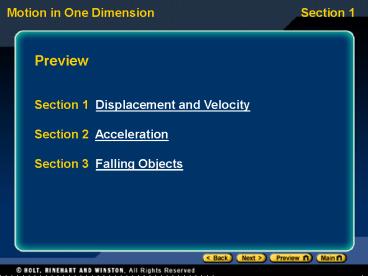Preview - PowerPoint PPT Presentation
1 / 24
Title:
Preview
Description:
Preview Section 1 Displacement and Velocity Section 2 Acceleration Section 3 Falling Objects – PowerPoint PPT presentation
Number of Views:73
Avg rating:3.0/5.0
Title: Preview
1
Preview
Section 1 Displacement and Velocity Section 2
Acceleration Section 3 Falling Objects
2
Frame of Reference
- Motion
- a change in position
- Frame of reference
- A point against which position is measured
- Example A train traveling between stations
- It is in motion when measured against the track.
- It is stationary when measured against a seat.
3
Frame of Reference
Click below to watch the Visual Concept.
Visual Concept
4
Displacement (?x)?
- Straight line distance from the initial position
to the final position (change in position) - Can be positive or negative
5
Displacement
- What is the displacement (in cm) for the objects
shown? - Answer 70 cm
- Answer -60 cm
6
Displacement - Sign Conventions
- Right (or east) ---gt
- Left (or west) ---gt
- Up (or north) ----gt
- Down (or south) ---gt
7
Average Velocity
- Average velocity is displacement divided by the
time interval.
- The units can be determined from the equation.
- SI Units m/s
- Other Possible Units mi/h, km/h, cm/year
8
Classroom Practice Problems
- A car travels 36 km to the north in 30.0 min.
Find the average velocity in km/min and in km/h. - Answer 1.2 km/min to the north or 72 km/h to the
north - A car travels 100.0 km to the east. If the first
half of the distance is driven at 50.0 km/h and
the second half at a 100.0 km/h, what is the
average velocity? - Answer 66.7 km/h to the east
9
Speed
- Speed does not include direction while velocity
does. - Speed uses distance rather than displacement.
- In a round trip, the average velocity is zero but
the average speed is not zero.
10
Graphing Motion
- How would you describe the motion shown by this
graph? - Answer Constant speed (straight line)
- What is the slope of this line?
- Answer 1 m/s
- What is the average velocity?
- Answer 1 m/s
11
Instantaneous Velocity
- Velocity at a single instant of time
- Speedometers in cars measure instantaneous speed.
- Determined by finding the slope at a single point
(the slope of the tangent)
12
Acceleration
- Rate of change in velocity
- What are the units?
- SI Units (m/s)/s or m/s2
- Other Units (km/h)/s or (mi/h)/s
- Acceleration 0 implies a constant velocity (or
rest)
13
Classroom Practice Problem
- Find the acceleration of an amusement park ride
that falls from rest to a velocity of 28 m/s
downward in 3.0 s. - Answer 9.3 m/s2 downward
14
Direction of Acceleration
- Describe the motion of an object with
- vi and a as shown to the left.
- Moving right as it speeds up
- Moving right as it slows down
- Moving left as it speeds up
- Moving left as it slows down
Vi a
-
- -
-
15
Acceleration
Click below to watch the Visual Concept.
Visual Concept
16
Graphing Velocity
- The slope (rise/run) of a velocity/time graph is
the acceleration. - Rise is change in v
- Run is change in t
- This graph shows a constant acceleration.
- Average speed is the midpoint.
17
Graph of v vs. t for a train
- Describe the motion at points A, B, and C.
- Answers
- A accelerating (increasing velocity/slope) to
the right - B constant velocity to the right
- C negative acceleration (decreasing
velocity/slope) and still moving to the right
18
Useful Equations
- 1.
- 2.
- 3.
- 4.
- 5.
19
Classroom Practice Problems
- A bicyclist accelerates from 5.0 m/s to 16 m/s in
8.0 s. Assuming uniform acceleration, what
distance does the bicyclist travel during this
time interval? - Answer 84 m
- An aircraft has a landing speed of 83.9 m/s. The
landing area of an aircraft carrier is 195 m
long. What is the minimum uniform acceleration
required for safe landing? - Answer -18.0 m/s2
20
Free Fall
- Assumes no air resistance
- Acceleration is constant for the entire fall
- Acceleration due to gravity (ag or g )
- Has a value of -9.81 m/s2
- Negative for downward
21
Free Fall
- For a ball tossed upward, make predictions for
the sign of the velocity and acceleration to
complete the chart.
Velocity (, -, or zero) Acceleration (, -, or zero)
When halfway up
When at the peak
When halfway down
-
zero -
- -
22
Graphing Free Fall
- Based on your present understanding of free fall,
sketch a velocity-time graph for a ball that is
tossed upward (assuming no air resistance). - Is it a straight line?
- If so, what is the slope?
- Compare your predictions to the graph to the
right.
23
Velocity and Acceleration of an Object at its
High Point
Click below to watch the Visual Concept.
Visual Concept
24
Classroom Practice Problem
- A ball is thrown straight up into the air at an
initial velocity of 25.0 m/s upward. Create a
table showing the balls position, velocity and
acceleration each second for the first 5 s.
t (s) y (m) v (m/s) a (m/s2)
1.00
2.00
3.00
4.00
5.00
20.1 15.2 -9.81
30.4 5.4 -9.81
30.9 -4.4 -9.81
21.6 -14.2 -9.81
2.50 -24.0 -9.81































